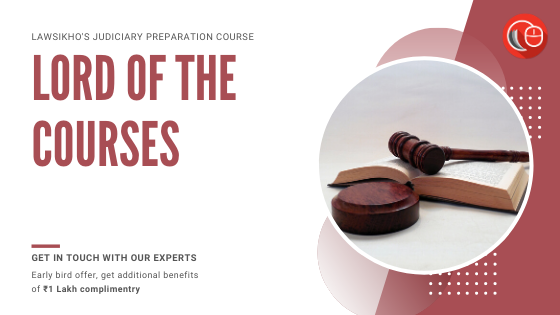This article has been written by Oishika Banerji of Amity Law School, Kolkata. This article discusses the procedural aspect of charge through notable case laws.
Table of Contents
Introduction
Chapter XVII of the Code of Criminal Procedure, 1973 lays down the provisions of charge spread over Sections 211 to 224. These provisions intend to provide that the “charge” shall be presenting a complete notice of the offences charged against the accused. The Calcutta High Court while deciding in the case of Mannalal Khatic v. State (1967) observed that the purpose behind a charge is to summarily spell out the charges levied on the accused because of the offence committed along with the prosecution’s allegations against him. A charge is to be considered as the foundation of any accusation as having been observed in the case of Ramkrishna v. State of Maharashtra (1980). It is therefore required to frame a charge properly so as to incorporate the available evidence supporting such charges. In this article, different ingredients, and elements that are involved in a charge, and function along with it have been discussed with the help of a few relevant judgments delivered by the Indian courts.
Charge under the Code of Criminal Procedure Code, 1973
While Sections 211-217 talk about forms of charge, Sections 218-224 discuss the concept of “joinder of charges”. A look into all of these provisions with the help of notable judgments has been provided hereunder.
Sajjan Sharma v. State of Bihar (2011)
The Supreme Court of India while deciding on the case of Sajjan Sharma v. State of Bihar (2011) held that both charge framing, and examination of the accused play a significant role in carrying out a criminal trial under Section 313 of the Code of Criminal Procedure, 1973. Put simply, these two can be considered essential steps of a criminal trial. In the present case, the appellant was falsely accused of the offence he did not contribute to, instead, it was his family members who were a part of an unlawful assembly that had taken place.
While taking a note of the facts of the case, the Apex Court remarked that in India, even while naming the accused as being associated with serious offences, it has been endemic that innocent persons or even members of the accused family of who might not have any role in the commission of offence are also roped in and falsely implicated. The Court went ahead to take a cue on the Patna High Court who had upheld the conviction of the appellant based on the charges framed against him. The Apex Court directed the High Court to carry out the framing of the charge and the examination of the accused in a mindful, and mechanical manner to avoid any kind of discrepancies.
Anasuri Simhadri v. Superintendent, Central Prison, Rajahmundry (1993)
Before discussing the present case, it is necessary to note that a court should not be undertaking a detailed analysis of the materials presented before it while framing charges against the accused. The only thing that should matter to the court is whether the materials that are being considered to frame charges and are presented by the prosecution are sufficient enough for the court to proceed further.
The case of Anasuri Simhadri v. Superintendent, Central Prison, Rajahmundry (1993) appeared before the Andhra Pradesh High Court concerning the significant traits of a charge which are clarity, and specificity. In the current petition, the plaintiff mentions that three stolen cycles were recovered from the accused possession thereby accusing him of three separate charges, but fails to provide evidence that would show that the possessions came to the accused at different points in time. In the absence of such evidence, the High Court held that the charges need not be dealt with separately, instead should be collectively taken into account and be disposed of as one offence committed by the accused. Therefore, the deterrents in association with the charges were to be running concurrently with each other in place of being separated.
Ranchhod Lal v. State of Madhya Pradesh (1965)
For quite a few times now, the article has discussed the need for a charge to be specific in order to let the accused know about the same. The question as to whether the absence of such specificity and particularity in the charges alleged against the accused, ipso facto render the charge to be invalid or not was taken for consideration by the Supreme Court of India in the case of Ranchhod Lal v. State of Madhya Pradesh (1965).
It was held that at times it might not be possible for the prosecution to get hold of the accurate information to present a precise charge against the accused before the court of law. It might happen that the amount of information available to the prosecution is difficult to be presented in a concise manner. But in such circumstances, the charge which has been levied may not turn out to be invalid. While Section 212 Code of Criminal Procedure, 1973 states the ingredients of a charge that is “particulars related to time, place, and person”, the Apex Court took a note of sub-clause 2 of Section 212 that is an exception to the provision and to the general rule provided under Section 218 of the Code.
Dhanjibhoy v. Karim Khan (1904)
Section 212 of the Code of 1973 talks about certain particulars in form of time, place, and person that are required to be present in a charge framed against an accused. In the present case of Dhanjibhoy v. Karim Khan (1904), while the court of law had to decide on the offence of criminal breach of trust, it stated that whatever number of breach of trust might have taken place in a period of one year, it was supposed to be treated as one offence committed by the accused. But if the series of the same act continues beyond a period of one year, then joinder of charges will be illegal in nature. Therefore, it was from this case, where the court interpreted the term “time” as provided under Section 212 to include a term of 1 year only.
Radha Sasidharan v. State of Kerala (2006)
Section 214 of the Code of Criminal Procedure, 1973 was interpreted by the Kerala High Court in the notable case of Radha Sasidharan v. State of Kerala (2006). The provision states that “words in charge taken in sense of law under which offence is punishable”. To simplify this phrase, the High Court while dealing with the present case stated that every word used in a charge to describe an offence committed by the accused shall be deemed to have been used in the sense that has been attached to them by the law under which such offence stands punishable. Therefore, in order to construe the section related to culpable homicide as only an error for causing hurt by unwholesome drugs, will tend to be misleading so far as the accused is concerned resulting in failure of justice so far as his opportunity to defend is concerned.
K Damodaran v. State of Travancore Cochin (1953)
The Supreme Court of India while deciding in the case of K Damodaran v. State of Travancore Cochin (1953) took into consideration the relevance of Section 215 read with Section 465 which deals with the effect of errors in the framing of charges, and reversal of finding, or sentence by reasons of the error, omission, or irregularity respectively. The top court viewed that a combined reading of both the provisions requires that whenever an error, irregularity, or omission accompanies framing of a charge the only question that a court must be considering is whether such hindrances have resulted in discrepancies in delivery of justice thereby causing prejudice to the accused’s defence. If the same happens then the court must be entertaining such hindrances.
Harjit Singh v. State of Punjab (2006)
The 2006 case of Harjit Singh v. State of Punjab (2006) that appeared before the Supreme Court of India was in concern with the failure of framing a charge as provided under Section 215 of the Code of 1973. The facts of the case involved the death of a wife by poisoning within seven years of her marriage with the appellant-husband. There was a lack of adequate evidence to frame charges under Section 306 of the Indian Penal Code, 1860 against the appellant. The Apex Court held that as in the first instance charges could not be framed under Section 306 of the Indian Penal Code, 1860, the plea of convicting the appellant could not be accepted.

Rafiq Ahmad v. State of Uttar Pradesh (2011)
The doctrine of legislation by incorporation was discussed by the Supreme Court of India in light of the case of Rafiq Ahmad v. State of Uttar Pradesh (2011). In the present case, charges for the offence of dacoity were framed under Section 396 of the Indian Penal Code, 1860, but the Court observed that the accused could be charged under Section 302 of the Indian Penal Code, 1860 as well without being charged in particular with it. The offence of murder was to be read along with Section 396. This was named as the doctrine of legislation by incorporation. This observation can therefore symbolise that non-framing of charge, or any kind of defect existing in a charge, will not be affecting the trial in any way.
Vibhuti Narayan Choubey v. State of Uttar Pradesh (2003)
The meaning of “alteration”, and “addition” of charges have been explained in the case of Vibhuti Narayan Choubey v. State of Uttar Pradesh (2003) by the Allahabad High Court. The Court observed that the phrase “alteration of charge” means changing or variation of an existing charge, whereas, “addition of charge” symbolises adding a new charge altogether. Thus addition to, or alteration of charges means one or more existing charges.
Re Ramalinga Odayar (1929)
The Madras High Court while hearing the case of In Re: Ramalinga Odayar vs Unknown (1929) observed that the accused charged with an offence will be having a right to recall prosecution witnesses after the alteration of the existing charge levied on him has taken place. This case has been discussed under the previous case for it was the former case that behaved as a precedent for the present one.
Queen Empress v. Fakirapa (1890)
Section 218 of the Code of Criminal Procedure, 1973 lays down the provision for “separate charges for distinct offences”. It was the case of Queen Empress v. Fakirapa (1890) where the Bombay High Court interpreted the objective behind this provision. The Court held that the purpose of Section 218 is to ensure that the accused have not been mystified in presenting his defence because of the number of charges levied on him and the charges are not interconnected with each other. Thus, Section 218 being an accused friendly provision promotes just, and equitable opportunities for the accused to present his defence before the concerned court of law.
R Dinesh Kumar v. State (2015)
The Supreme Court in the well-known case of R Dinesh Kumar v. State (2015) addressed the issue as to whether a person can be tried on grounds of committing an offence along with the accused who are facing the trial already or not. The Apex Court held that where there are several persons who have been alleged to have committed various offences which are not wholly unconnected with each other, there may be a joint trial unless such a trial can embarrass the accused in defending himself before the concerned court.
Conclusion
As we come to the end of this article, it is necessary to mention that the case laws that have been discussed here are not exhaustive in nature, which is to say that there exist a plethora of cases beyond what has been mentioned concerning the charge.
References
- https://districts.ecourts.gov.in/sites/default/files/MANJULA%20ADDLJCJ%20SIRCILLA.pdf
- https://www.mondaq.com/pdf/clients/318472.pdf
- https://corporate.cyrilamarchandblogs.com/2021/05/supreme-court-on-section-482-crpc-have-the-inherent-powers-of-high-courts-been-diluted/
- https://lawcommissionofindia.nic.in/reports/177rptp2.pdf
LawSikho has created a telegram group for exchanging legal knowledge, referrals and various opportunities. You can click on this link and join:
https://t.me/joinchat/J_0YrBa4IBSHdpuTfQO_sA
Follow us on Instagram and subscribe to our YouTube channel for more amazing legal content.
 Serato DJ Crack 2025Serato DJ PRO Crack
Serato DJ Crack 2025Serato DJ PRO Crack










 Allow notifications
Allow notifications



